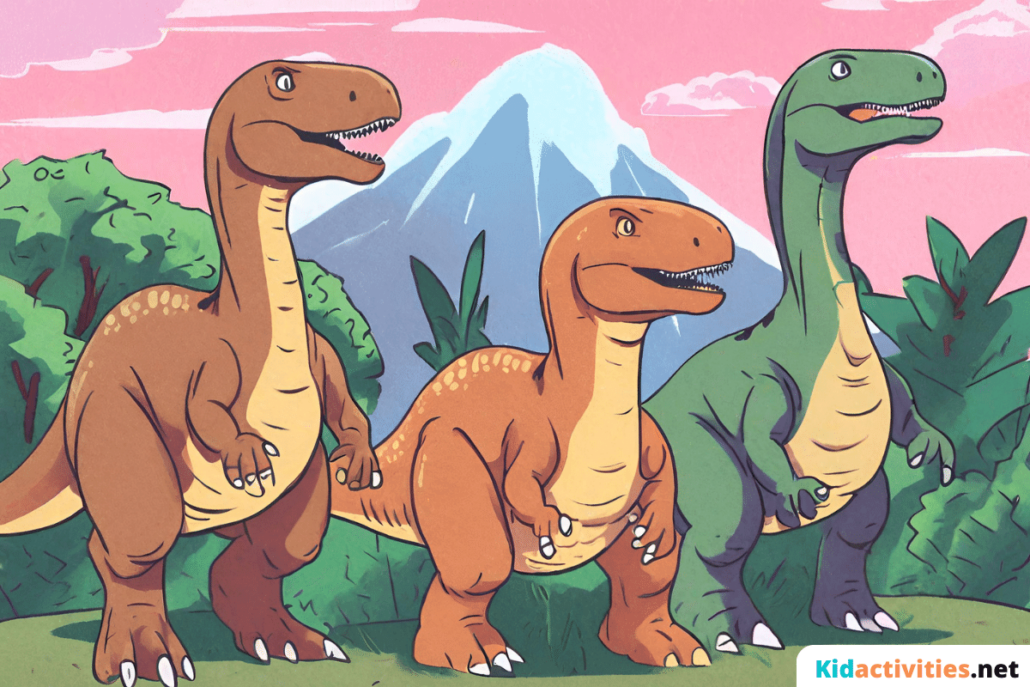
Learning about dinosaurs is a roaring good time! These thrilling prehistoric creatures hold some surprises up their scales. Quiz your dino-loving kid or students to see how much they know!
Below, you will find trivia questions about dinosaurs divided by chronological period of existence, from the earliest known dinos up to modern-day dinosaur descendants. Get ready to think like a paleontologist!
Triassic: 251 – 201 Million Years Ago
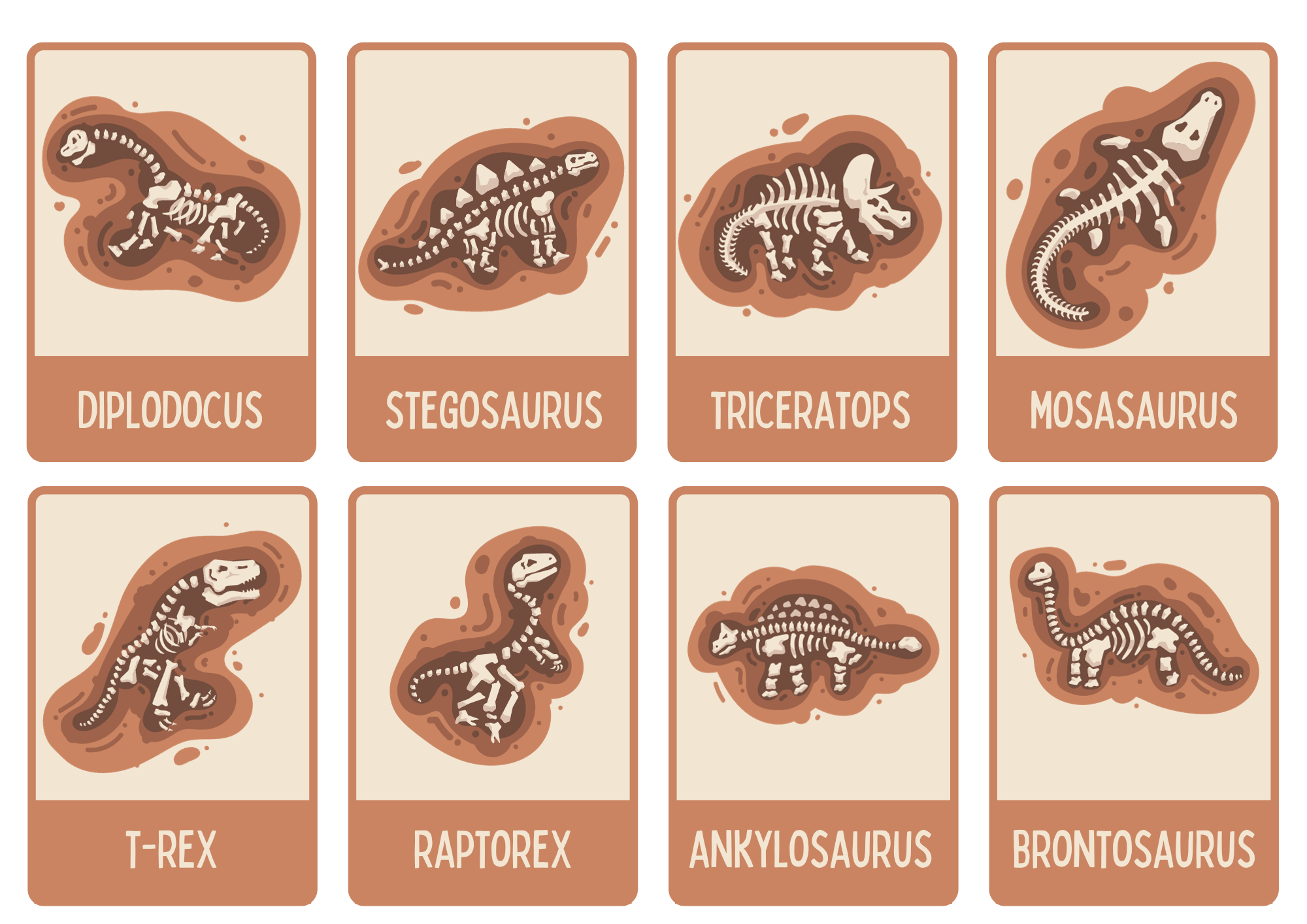
Q: The earliest dinosaurs in the Triassic period are believed to have been mostly what type of creatures?
a. Small and bipedal (walks on two legs)
b. Small and quadrupedal (walks on four legs)
c. Large and bipedal (walks on two legs)
d. Large and quadrupedal (walks on four legs)
Answer
Q: The Triassic dinosaurs are classified into two groups: Saurischia and Ornithischia. What distinguishes these groups from one another?
a. Shape of skull
b. Size of brain
c. Hip structure
d. Number of legs they walk on
Answer
Q: What creature was the pelvis structure of the Saurischia most similar to?
a. Bird
b. Lizard
c. Fish
d. Large cat
Answer
Q: What creature was the pelvis structure of the Ornithischia most similar to?
a. Bird
b. Lizard
c. Fish
d. Large cat
Answer
Q: On which continents did the Sauropod dinosaurs live?
a. North and South America
b. Europe and Asia
c. Africa and Australia
d. All of the continents, including Antarctica
Answer
Q: What does “theropod” mean when referring to “theropod dinosaurs?”
a. Plant-eating
b. Meat-eating
c. Beast-footed
d. Flat-footed
Answer
Q: The lambeosaurs had a crest that served what purpose?
a. It intimidated potential predators
b. It acted as a snorkel so they could breathe underwater
c. It attracted mates
d. It allowed them to spear prey
Answer
Q: What are the two types of remaining descendants from archosaurs?
a. Birds and crocodiles
b. Alligators and Komodo dragons
c. Geckos and lizards
d. Snakes and fish
Answer
Q: What creature did the Pseudosochia archosaurs primarily relate to?
a. Birds
b. Crocodiles
c. Fish
d. Snakes
Answer
Q: What creature did the Ornithosuchia archosaurs primarily relate to?
a. Birds
b. Crocodiles
c. Fish
d. Snakes
Answer
Q: What type of dinosaur is the oldest known creature to give birth to live young?
a. Lepidosaurs
b. Phytosaurs
c. Dinocephalosaurus
d. Pterosaurs
Answer
Q: What is theorized to have caused the extinction of many dinosaurs from the Triassic period?
a. An ice age
b. Volcanic activity that produced acid, carbon dioxide, and sulfur dioxide
c. A worldwide earthquake
d. Global warming
Answer
Jurassic: 201 – 145 Million Years Ago
Q: What type of eater was the Apatosaurus (formerly known as Brontosaurus)?
a. Herbivore (plant-eating)
b. Carnivore (meat-eating)
c. Omnivore (plant and meat-eating)
d. Pescatarian (plant and sea-based diet)
Answer
Q: How long could an adult Barosaurus grow to?
a. 52 – 59 feet
b. 62 – 69 feet
c. 72 – 79 feet
d. 82 – 89 feet
Answer
Q: What was a unique physical feature of the Plateosaurus?
a. A forked tail
b. Hooves
c. 5-fingered hands with a thumb claw
d. An extra spout for breathing towards the top of the head
Answer
Q: How big were the sharp teeth of the meat-eating Allosaurus?
a. 1 – 3 inches
b. 2 – 4 inches
c. 3 – 5 inches
d. 4 – 6 inches
Answer
Q: What did the Camarasaurus swallow to help break down their food?
a. Stones
b. Bones
c. Dinosaur eggs
d. Bacteria-infested water
Answer
Q: What was the purpose of the beak of the Camptosaurus?
a. To reach insects from inside logs and tree trunks
b. To peck at live prey
c. To scoop fish from rivers
d. To nibble at vegetation
Answer
Q: What two body parts caused the Diplodocus to be one of the longest dinosaurs?
a. Legs and neck
b. Torso and tail
c. Neck and tail
d. Legs and torso
Answer
Q: How long could the neck of the Mamenchisaurus stretch?
a. 20 feet
b. 30 feet
c. 40 feet
d. 50 feet
Answer
Q: What are two adjectives that describe the Ornitholestes?
a. Small and fast
b. Small and slow
c. Large and fast
d. Large and slow
Answer
Q: How do scientists believe the stegosaurus used its spikes and plates on its back and tail?
a. To stay balanced
b. To store water
c. To defend themselves
d. To shred tree bark
Answer
Q: What mountain range (between France and Switzerland) is the Jurrasic period named after?
a. Blue Ridge Mountains
b. Swiss Alps
c. Jura Mountains
d. The Himalayas
Answer
Q: What does the Greek root, “saurus” mean?
a. Prehistoric
b. Scaly
c. Lizard
d. Reptilian
Answer
Cretaceous: 145 – 66 Million Years Ago
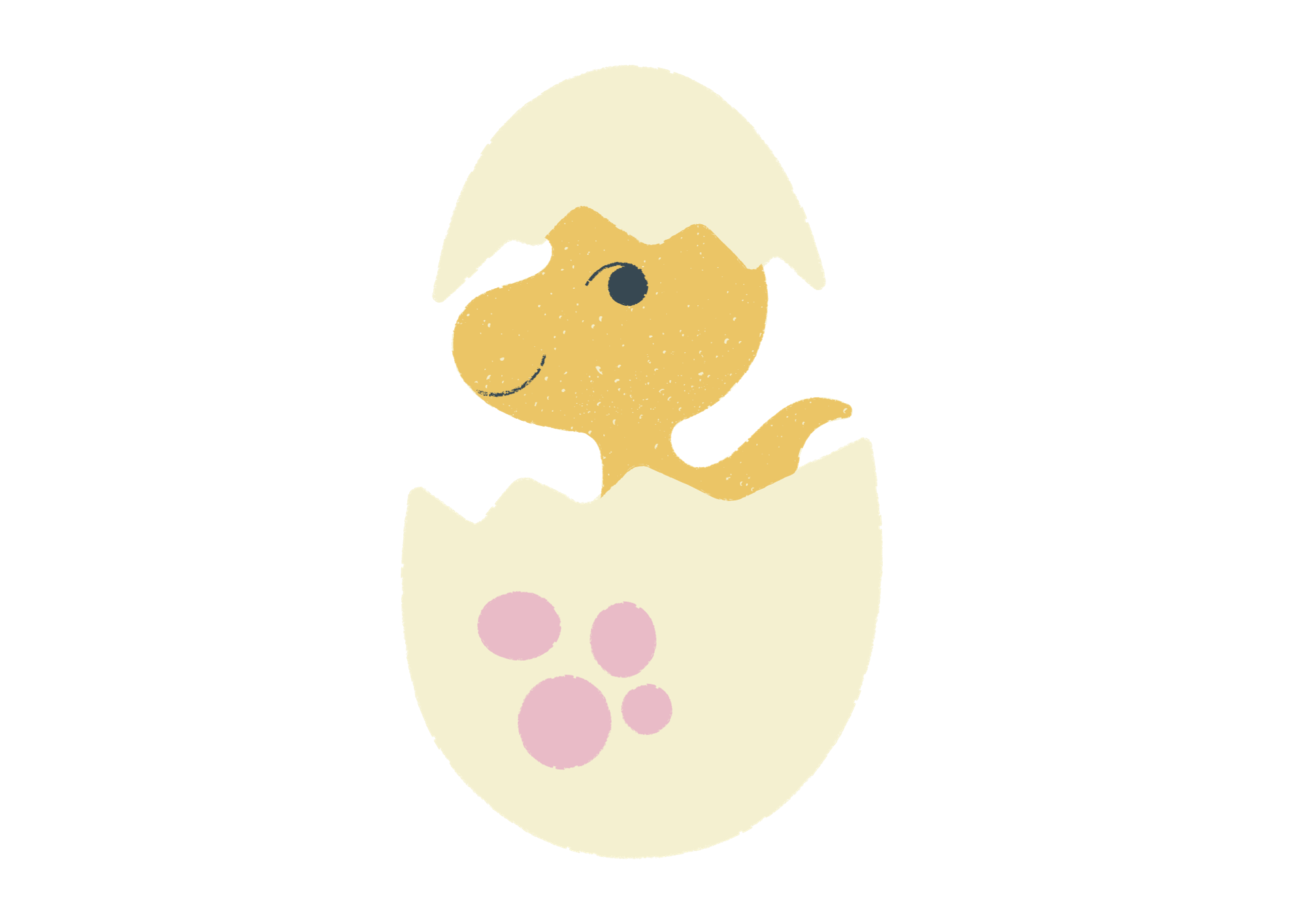
Q: What did the Albertosaurus eat?
a. Vegetarian
b. Dinosaur eggs from nests
c. Fish and snakes from rivers
d. Smaller, plant-eating dinosaurs
Answer
Q: How did the Albertosaurus hunt for their food?
a. Alone and only at night
b. In packs to chase down live prey or steal prey from other dinos
c. They remained still in a river until prey swam by
d. They used their young as a distraction while they invaded dinosaur nests
Answer
Q: About how many Tyrannosaurs Rex dinosaurs existed in total?
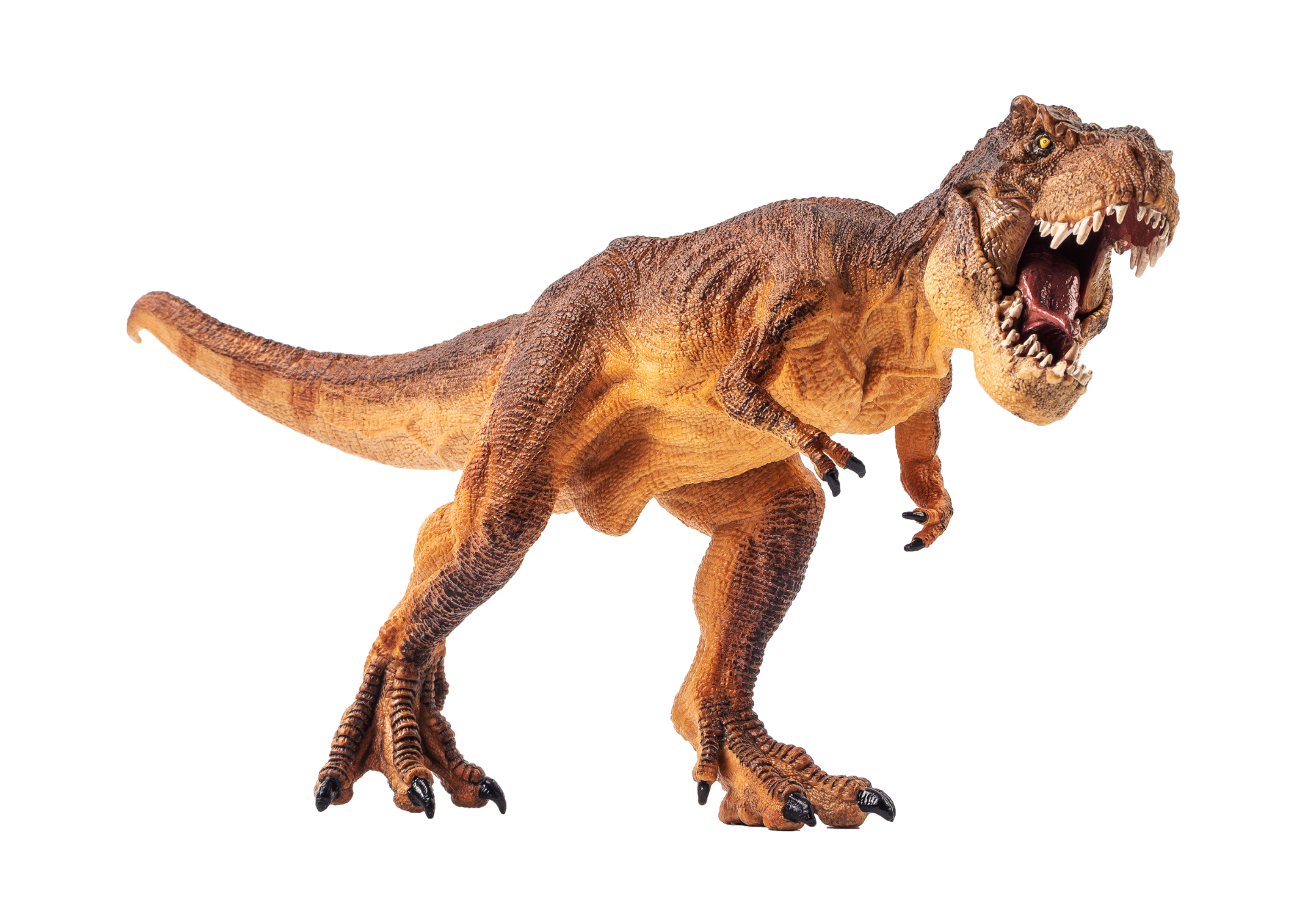
a. 1 million
b. 1 billion
c. 2.5 million
d. 2.5 billion
Answer
Q: How fast could the Tyrannosaurus Rex run?
a. Up to 3 miles an hour
b. Up to 6 miles an hour
c. Up to 9 miles an hour
d. Up to 12 miles an hour
Answer
Q: Which continent did the Velociraptor live on?
a. Africa
b. Asia
c. Antarctica
d. Australia
Answer
Q: Which of the following is a descendant of the Velociraptor?
a. Turtle
b. Turkey
c. Tuna
d. Tuxedo cat
Answer
Q: What was the average lifespan of the Triceratops?
a. 40 – 50 years
b. 60 – 70 years
c. 80 – 90 years
d. 100 – 110 years
Answer
Q: How many horns did the Triceratops have on its head?
a. Zero
b. One
c. Two
d. Three
Answer
Q: What is a distinct facial feature of the Anatotitan?
a. A duck-billed snout
b. Two noses
c. An underbite
d. Whiskers
Answer
Q: How did the Anatotitan reproduce?
a. Live birth
b. Laying eggs
c. Keeping fetuses in a pouch
d. Underwater birth
Answer
Q: What could be found at the end of the tail of the Ankylosaurus?
a. A spike
b. A sac of venom
c. A club
d. A crest
Answer
Q: What direction did the Ankylosaurus typically swing its tail?
a. Up and down
b. Side to side
c. In a circle
d. At random
Answer
Cenozoic: 66 Million Years Ago to Present Day
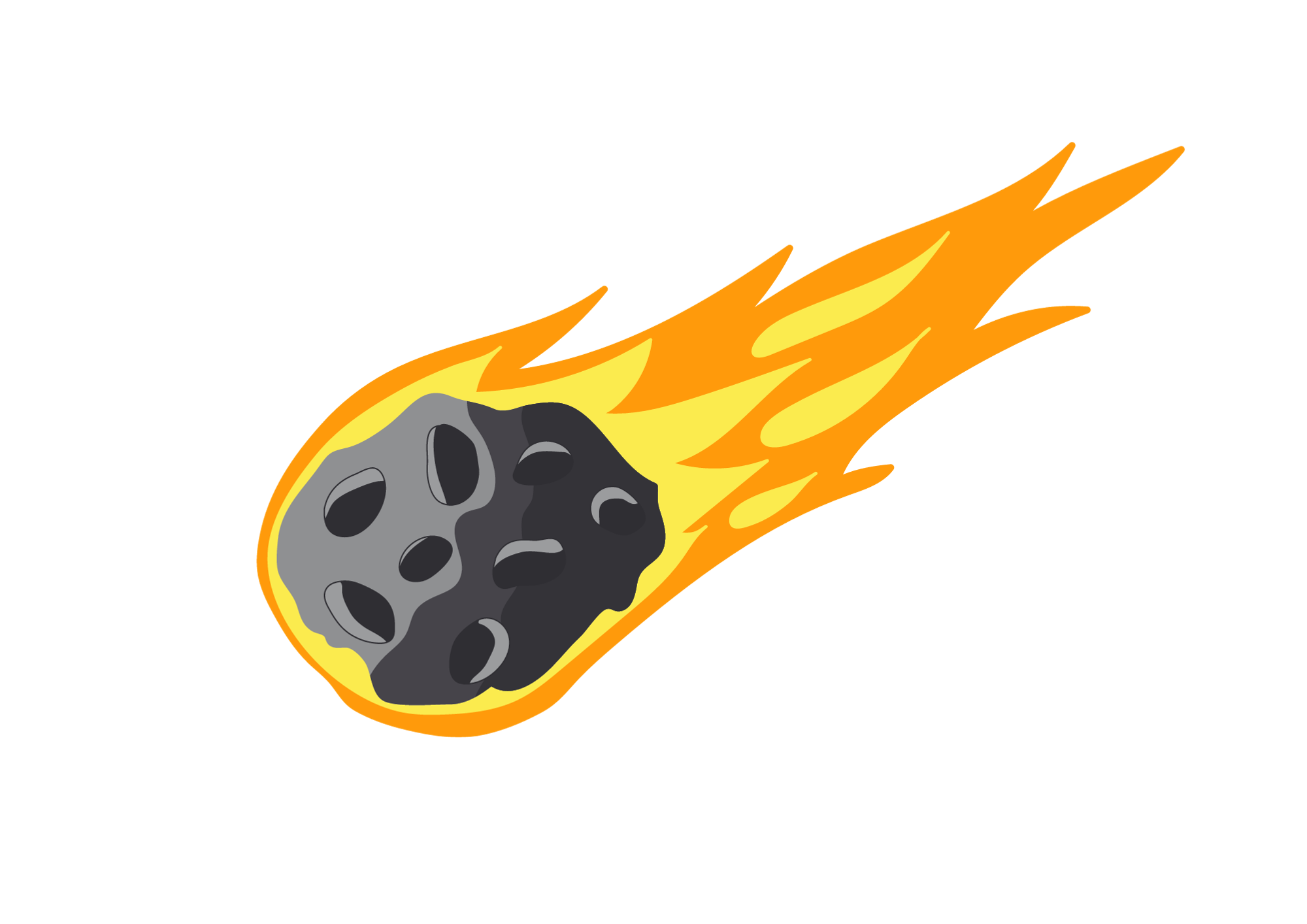
Q: How long did dinosaurs live on Earth before a mass extinction event?
a. 50 million years
b. 100 million years
c. 165 million years
200 d. years
Answer
Q: There is a theory that an asteroid hit the earth, sparking a mass extinction of the dinosaurs. In which modern-day country did this asteroid land?
a. Canada
b. The United States
c. Mexico
d. Brazil
Answer
Q: What modern-day country is home to the site of the volcanic activity that also contributed to the extinction of the dinosaurs?
a. China
b. India
c. Australia
d. Italy
Answer
Q: What is the only living animal that is larger than the dinosaurs?
a. Giant squid
b. Whale
c. Crocodile
d. Kangaroo
Answer
Q: Around how many years ago did dinosaurs go extinct?
a. 6 million years ago
b. 16 million years ago
c. 66 million years ago
d. 166 million years ago
Answer
Q: Which of the following is NOT a dinosaur descendant?
a. Ostrich
b. Sea Turtle
c. Shark
d. Jellyfish
Answer
Q: Which dinosaur does the chicken share a good deal of DNA with?
a. Triceratops
b. Tyrannosaurus Rex
c. Allosaurus
d. Velociraptor
Answer
Q: What helps scientists learn more about dinosaurs?
a. Journals from people who lived at the time
b. Fossils
c. Photographs from long ago
d. Cave drawings
Answer
Q: How many extinct dinosaurs do we currently know about?
a. Around 700 million
b. Around 900 million
c. Around 1100 million
d. Around 1300 million
Answer
Q: How wide was the asteroid that caused the first mass extinction of the dinosaurs?
a. 1 mile
b. 6 miles
c. 11 miles
d. 17 miles
Answer
Q: About how much of the dinosaur population is estimated to have been killed due to the asteroid?
a. 25%
b. 50%
c. 75%
d. 100%
Answer
Q: About how much time passed between the mass extinction of the dinosaurs and the first appearance of early humans?
a. 30 million years
b. 65 million years
c. 90 million years
d. 165 million years
Answer
You did a dino-mite job at answering these trivia questions! Don’t let your knowledge go extinct. Share the fun by quizzing your friends!
